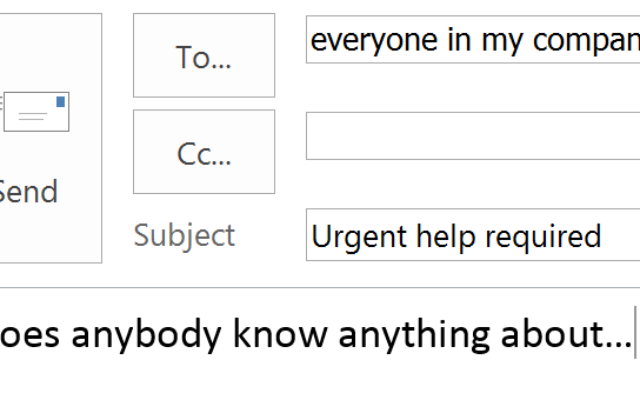Email is over 40 years old and according to Ray Tomlinson, the man that invented it, the content of that first email was ‘entirely forgettable’. Over 40 years later, not much has changed. Email continues to be the default means of business communication despite the numerous flaws we have all come to accept. I’d like to take just a moment to collectively remind ourselves of those flaws in the hope that 40 years from now I won’t be writing another article with the same title….
1. It’s expensive. It’s a huge IT bill to pay for the space, the licences, the software, the servers the backups and then to maintain the servers, pay for the IT team that manages them, pay the HR team that looks after them etc, etc. It’s a criminal waste of money for something employees probably can’t access from anything but their desktop when cloud-based solutions take away the majority of the cost and make the service available 24/7, 365 on any device!
2. It’s slow. Yes, you heard me. I know information flows at the speed of light around our world and you can have a response to an email in minutes, but, the act of typing in an email address, hitting the reply button, sending off a packet of information and then waiting for another packet to come back. It’s too darn slow. The conversations I have via pretty much any other communications platform I use are SO much quicker to use, they’re immediate. And people can’t say they never received them…
3. It’s insecure. Email is like saying someone who has your home address is allowed to walk in and take a seat at your table, and only then do you get to decide whether to kick them out or not. If someone gets hold of your email address there’s nothing to stop them emailing you from one or a hundred different accounts. You then have to hope your security and anti-spam software is clever enough to remove the dangerous items, without removing the genuinely useful ones. Closing the stable door after the horse has bolted? On pretty much every other platform I use I have the flexibility to simply block people, set my security to allow only those people I already trust to contact me, or many options in between.
4. It’s inaccurate. Emails are only slightly more accurate than carrier pigeons. Ever tried to tell someone your email address, which they try to remember or scribble down on a scrap of paper? Ever get those emails? Ever wondered whether they lost the paper, couldn’t read their own writing, read their writing but misspelled it when typing it in… or probably all of the above? On pretty much every other platform I use I can tell who the person is by a picture, or some other meta-data or the fact we have connections in common. I don’t need to know their ‘address’ where anything less than 100% accuracy means it won’t arrive, or worse, will arrive in someone else’s inbox…
5. It’s irrelevant. Email, especially in the office environment, is often worse than spam, because you can’t protect yourself from the endless “does anybody know anyone who knows anything about” emails which come around 5 times a day because the poor chump on the other end has no way of knowing who the relevant people are to send it to. It’s also a blank slate, meaning when people do send those emails you sometimes have to read an essay before you realise it’s not relevant to you. And that just cost you 10 minutes, plus the time it’s now going to take you to re-focus, wait, another urgent mass email just came in! Intelligent platforms are now using matching technology to help people find the right people to speak to, and to help people find the right opportunities for them to get involved with. They’re helping us to ask good questions, which is saving all of us time.
6. It’s transactional. I mean, put your hands up if you think email is a great way to collaborate on a document? You send out the original, you get three copies back and then spend an hour trying to smash them together, only then to realise one of the copies you got back was an older version, or they weren’t in the branched off email chain which made some pertinent points they missed… argh. There is a better way. We can all now work on documents together, faster, with more transparency and accountability. Sharepoint kicked this off in the workplace but there are now many competitors offering this functionality.
7. It’s lost. Looking for emails is like looking for a straw of hay in a stack of needles. And you only have your stack to look through. The exchange servers of any company probably house the vast majority of all their corporate knowledge. It’s unsearchable and what’s worse… it’s probably all deleted when the employee leaves the organisation, meaning all that corporate knowledge just walked out the door with them. Pretty much every social platform I use stores that corporate knowledge in the cloud, where it is easily searchable and will remain long after I’ve gone.
So come on world. There is a better way.
Article by channel:
Everything you need to know about Digital Transformation
The best articles, news and events direct to your inbox
Read more articles tagged: Featured






